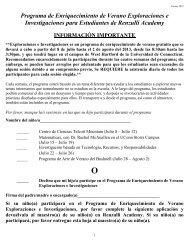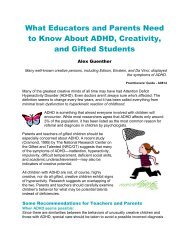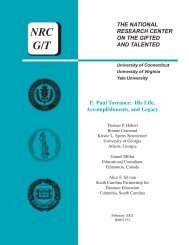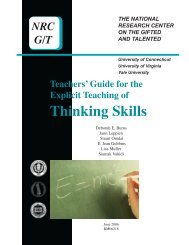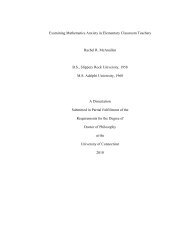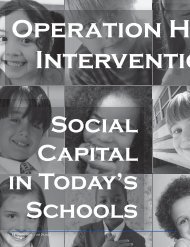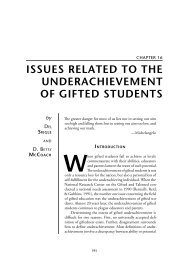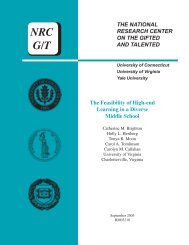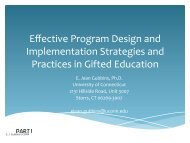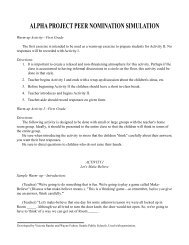Giftedness and High School Dropouts - Neag Center for Gifted ...
Giftedness and High School Dropouts - Neag Center for Gifted ...
Giftedness and High School Dropouts - Neag Center for Gifted ...
You also want an ePaper? Increase the reach of your titles
YUMPU automatically turns print PDFs into web optimized ePapers that Google loves.
2<br />
dropouts are gifted students. The Marl<strong>and</strong> report (cited by Irvine, 1987) also stated that<br />
18% of dropouts are gifted. However, Irvine (1987) believed that dropout rates <strong>for</strong> gifted<br />
students have been misrepresented. In fact, a wide range of estimates exists <strong>for</strong> the<br />
percentage of gifted students who drop out of school. These gifted dropout estimates<br />
vary with the definitions of giftedness <strong>and</strong> dropouts. Lajoie <strong>and</strong> Shore (1981) criticized<br />
previous gifted dropout studies because they gave vague definitions of gifted students,<br />
because the students varied in age <strong>and</strong> grade levels, <strong>and</strong> because they needed follow-up<br />
on the permanence of the drop out. Regardless of the actual rate of gifted students who<br />
drop out of school, they are the loss of a national resource that cannot be ignored.<br />
Previous studies about gifted dropouts have focused on academically high ability<br />
students, selected primarily by IQ scores. However, recent trends <strong>for</strong> defining gifted <strong>and</strong><br />
talented students have become more broad <strong>and</strong> flexible. In his three-ring conception of<br />
giftedness, Renzulli (1986) argued that there is no single criterion <strong>for</strong> "giftedness."<br />
Rather, interaction among the three clusters of traits including (a) above average, though<br />
not necessarily superior ability, (b) task commitment, <strong>and</strong> (c) creativity contribute to the<br />
development of gifted behaviors. According to this theory, nonintellective factors like<br />
motivation are also important <strong>and</strong> should be considered. The Javits <strong>Gifted</strong> <strong>and</strong> Talented<br />
Students Education Act defined children with outst<strong>and</strong>ing talent, supporting the broad<br />
definition of gifted:<br />
Children <strong>and</strong> youth with outst<strong>and</strong>ing talent per<strong>for</strong>m or show the potential <strong>for</strong><br />
per<strong>for</strong>ming at remarkably high levels of accomplishment when compared with<br />
others of their age, experience, or environment. These children <strong>and</strong> youth exhibit<br />
high per<strong>for</strong>mance capability in intellectual, creative, <strong>and</strong>/or artistic areas, possess<br />
an unusual leadership capacity, or excel in specific academic fields. They require<br />
services or activities not ordinarily provided by the schools. Outst<strong>and</strong>ing talents<br />
are present in children <strong>and</strong> youth from all cultural groups, across all economic<br />
strata, <strong>and</strong> in all areas of human endeavor. (U.S. Department of Education, 1993,<br />
p. 26)<br />
As Lajoie <strong>and</strong> Shore (1981) indicated, the study results that include a broad<br />
definition of giftedness may differ from those that use a restricted definition, but it is not<br />
clear how they might differ. Another issue in the study of gifted dropouts is the difficulty<br />
in obtaining nationally representative longitudinal data about this population (Robertson,<br />
1991). Although various research studies have been proposed <strong>for</strong> studying high school<br />
dropouts, Kunkel, Pittman, Curry, Hildebr<strong>and</strong>, <strong>and</strong> Walling (1991) indicated that<br />
previous research studies have failed to clarify the process of dropping out because they<br />
examined only a few variables such as student or institutional characteristics. Willett <strong>and</strong><br />
Singer (1991) also noted that research on dropouts' needs should focus on these<br />
questions: Are students more at risk of leaving during particular stages of their<br />
education Does the level of risk differ across racial groups Do particular policies <strong>and</strong><br />
programs have an impact The authors recommend follow-up studies, which investigate<br />
a single cohort of students <strong>for</strong> several years. Tinto (1975, 1982, 1988) linked attrition to<br />
academic <strong>and</strong> social integration <strong>and</strong> considered such attrition to be a process that occurs<br />
over time, rather than a discrete event isolated from students' other experiences (Kunkel




